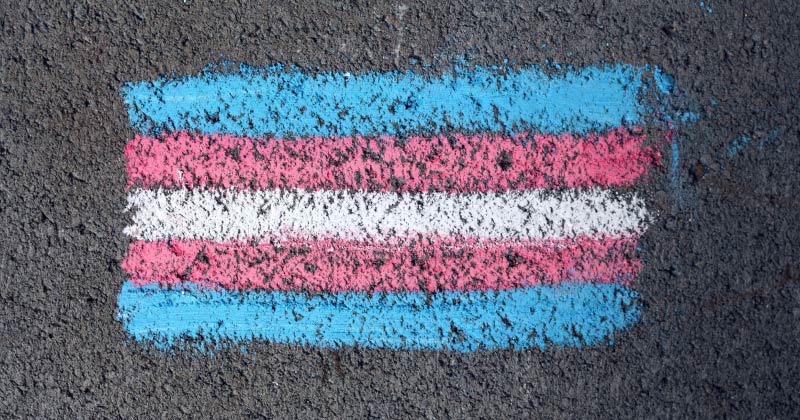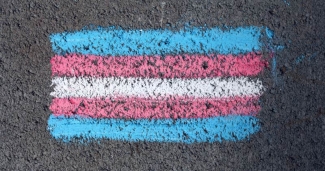When My Sister Came Out as Trans, the Political Became Personal

[Editor’s Note: It’s the last day of Pride Month. Here, we offer this personal piece from Ashley-Michelle Papon, MCN Project Coordinator. Lesbian, gay, bisexual, transgender, queer, intersex, asexual and all gender minority (LGBTQIA+) people form part of all communities, including agricultural worker, migrant, immigrant, and refugee communities. You can find resources for LGBTQIA+ patients at the National LGBTQIA+ Health Education Center.]
Years ago, I read a quote on a message board that changed my life. The posters were debating the implications of the hotly contested election results that declared Republican George W. Bush the president over Democratic challenger John Kerry. Arguing from a place of fear of what Bush’s win meant on a number of social issues, the poster chaffed at the insistence of conventional wisdom that political disagreements were not worth sacrificing personal relationships. “The personal is political,” she argued. “Especially when it comes to my right to exist as a trans person.”
These words were transformative for me. It served as my introduction to the community of trans people. Prior to this, the breadth of my familiarity with this population was limited to stand-up comedian Eddie Izzard and midnight showings of “The Rocky Horror Picture Show.” In other words, it would be appropriate to describe my understanding as one-dimensional. After that time, I worked to expand my umbrella of advocacy to include trans rights, prioritizing efforts to better understand this population, their health needs, and their risks. Yet these experiences still showcased that my understanding was purely theoretical; I had no anchor in personal experience.
Until last week, when a sibling of mine decided to celebrate June’s status as Queer Pride Month by coming out as trans.
I wish I could say my years of being an ally had prepared me to recognize the signs; to express our incredibly close relationship meant I knew all along and was simply waiting for her to reach the place where she could tell me herself. Unfortunately for my credibility as an ally, and more importantly for the well-being of my sister, none of that proved to be true.
When my sister began talking with me about her own evolving political ideology, I assumed her sudden interest in philosophy about gender reflected the change of environment. It wasn’t all that long ago that I spirited her away from our hometown in Kansas to attend a more inclusive high school in my part of California. Her friend group encompassed a wide array of gender identities and sexual orientations. I attributed her new fixation on deconstructing gender in casual conversation to be a byproduct of her desire to stand in solidarity with her spectrum-ranging peers. While this point may sound defensive in nature, it nevertheless must be made: trans experiences do not exist in a monolith. All of the well-intentioned education on the subject that arguably tries to serve as primers for “How to Tell if You’re Loved One is Trans,” miss the mark. The process of transitioning is highly individualized.
One thing that tends not to be so individualized: the risks facing trans people, particularly those of color, like my sister.
My sister and I share the same white father, which gives us the ability to pass when we choose. Our mothers are both recognized Native women through their immediate parentage, and in the case of my sister, that parentage also includes Latin American roots. In fact, my sister is often mistaken for being a lighter-skinned Latinx; not enough consideration is given for the complexity of being multiracial, especially as trying to explain her own identity along racial lines is confusing.
I mention it because racial and ethnic identities significantly influence the quality of life for trans folks, including life expectancy. The pandemic and its aftermath reduced life expectancy for all Americans by at least a year during the first half of 2020, and adjustments for subsequent tangential developments, like drug overdoses and suicides, are still being made. Black and Latinx Americans experienced the greatest loss of life expectancy. That number dips even lower for trans folks of color due to their disproportionate risk of experiencing violence.
Violence is a very real and present danger, representing a distinct risk for trans people of color. Last year was recognized as one of the deadliest years on record in the United States, as people struggled with the economic and social implications of the pandemic. While some evidence strongly supports the conclusion that the uptick in violence across major cities was already on the rise before the hardships of the Coronavirus, the subsequent lockdown introduced new risk factors, with isolation playing a key role in the episodes of trans-centric consequences, including violence. While poverty, homelessness, and unemployment are common struggles for the trans community, COVID-19 amplified these vulnerabilities, as many trans people were forced to retreat into unsafe dynamics in order to shelter in place, from struggling to access gender-affirming care via telehealth to living with unsupportive families of origin. The increased danger of everyday living for the trans community, particularly people of color, resulted in at least 45 fatalities by the year’s end.
Sadly, this trend is only accelerating in 2021. So far, there have been nearly thirty acts of homicide against trans and gender-nonconforming people, with the vast majority of these victims being Black or Latinx trans women. Studies have suggested that a strong link exists between the increase of anti-trans violence and the record-number of anti-trans bills that have been introduced since the pandemic began. Each piece of legislation perpetuates the idea that the very presence of trans people is a threat, and that the trans community is itself a threat to more “traditional” societal norms. The bills focus on hot-button culture war issues, such as fear of trans folks in gendered bathrooms, or supposed advantages trans children may enjoy over their peers in sports. The latter in particular has had a resurgence in popularity, thanks to vocalized support from the former reality TV fixture.
Yet when it comes to the spillover effect of anti-trans legislation on trans lives, there is no middle ground. These proposed and implemented laws assume that the general public needs to be protected from trans people, when the reality is that trans people are the ones in need of protection. In spite of the terrifying rates of violence, trans people are not protected by the law uniformly in the US. According to the Movement Advancement Project, an independent and nonprofit thinktank dedicated to tracking inequity across the United States, only 22 states have laws expressly prohibiting discrimination on the basis of sexual orientation and gender identity, and the inequity impacts every facet of life for trans people, from employment and housing to education and health care.
Perhaps somewhat ironically, escaping these dynamics in their home countries serves as a major motivator for immigrants coming to the United States, particularly from Latin America. The Trans Murder Monitoring, a research project which actively tracks such data, reveals that at least 286 murders of trans or gender-diverse people occurred in Latin America between 2019 and 2020. Despite the risks posed by crossing into the country as an undocumented person, many trans folks have drawn the conclusion it represents their only chance for safely living. Escaping persecution due to one’s status as a trans person is, from a legal perspective, a valid reason for seeking asylum.
Of course, the United States makes no promises about delivering trans immigrants out of such persecution once an immigrant is detained. Abuses in detention are so rampant that numerous lawsuits have been filed against a number of facilities, citing a variety of offenses on the part of administrators and employees: sexual abuse, withheld medical care, and overt negligence being among the most common. One suit, filed last year seeking to have all trans detainees released amidst the inadequate medical care in the face of the pandemic, charged that “ICE’s failures have made detention centers death traps for transgender people in civil immigration detention.”
Health care abuse and neglect represent the most common complaints detainees have upon release. Care that is dispensed is frequently delayed, mismanaged, and rife with antagonism against the trans population. Until recently, trans immigrants were routinely housed with the population of the sex assigned to them at birth, rather than their gender identity. As a result of this discrepancy, trans inmates were singled out for solitary confinement, often for months at a time, a barbaric practice that has been found to increase both physical and mental health consequences, particularly suicidal ideation and episodes of psychosis. Trans inmates were isolated for 99 days on average—twice the length of time that the Journal of American Academy of Psychiatry and the Law identified caused significant psychological distress.
Although the Obama administration issued guidelines designed to serve as best practices for trans immigrants—which include recognizing their authentic gender—following them is at the discretion of each individual detention center. The underlying ethos of such a hands-off approach ultimately questions the individual’s fundamental right to life. As Kate Sosin writes for the 19th, a nonprofit news outlet which focuses on gender-focused politics and policy, the proliferation of 127 anti-transgender bills introduced across state governments signals an acceptance of the deadly stigma directly responsible for prompting acts of violence against trans individuals. Speaking out following the murders of two trans women of color in North Carolina, Sosin cites the comments Rob Tufano, a spokesperson for the Charlotte-Mecklenburg Police department, cautioning the community that “There has probably arguably never been a more vulnerable time for them.”
Although we’ve seen some progress on the part of the Biden administration to protect trans rights, society is a long way from reconciling where trans rights are with where they need to be. It is a reality that I am forced to grapple with in a more intensely personal way than I could have ever imagined. Beyond being a highly sensitive person, I am also one who has had to contend with tremendous loss; two of my siblings died before I was ever born, and those losses have deeply shaped the landscape of my family. As my own children can attest, I often veer too far into the territory of overprotectiveness, and as I also currently have a guardianship role over my sister, the desire to protect her is even stronger than for either my twin brother or our elder brother. It is a feeling that is part-and-parcel of the human experience, and the cruel irony here is that those same protective instincts are being weaponized in an attempt to convince an entire generation that trans folks are a threat to their children. If I have learned anything at all, as an ally, as a mother, as a human being who loves her sister fiercely, it is this: it is our job to make sure that trans people have the same rights, same freedom to live, same access to health and well-being as all people.
Got some good news to share? Contact us on our social media pages above.
Return to the main blog page or sign up for blog updates here.
- Log in to post comments
